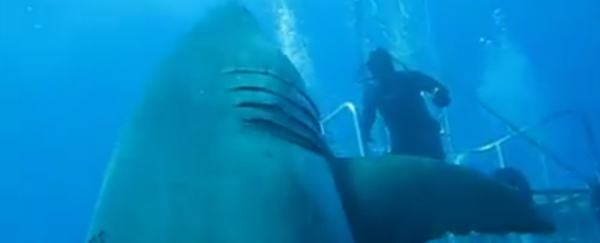Deep Blue (The biggest shark ever filmed) second part Posted by Mauricio Hoyos Padilla on Monday, August 10, 2015
Just two months after shark expert Mauricio Hoyos Padilla published the first footage of what's been described as "the largest great white shark ever filmed", the Mexican diver has released another video so we can all bask in the glory that is Deep Blue.
Deep Blue is a 6-metre-long female great white shark, and the footage captured by Padilla in 2013 near Guadaulpe Island in Mexico shows that she was heavily pregnant at the time, which added to her already impressive stature. It's believed that she's at least 50 years old.
"When I saw Deep Blue for the first time, there was just one thought in my mind: HOPE," Hoyos Padilla writes in a blog post about the encounter. "A shark of that size is at least 50 years old, and that tells me protection and conservation efforts are really working. … During November and December we have seen several white shark pregnant females like Deep Blue in Guadaulpe Island feeding on seals, satisfying their needs to feed their pups."
We appreciate your sacrifice, ill-fated seals.
Guadaulpe is a volcanic structure located approximately 240 km off the west coast of Mexico's Baja California Peninsula. Hoyos Padilla has been diving here for the past 13 years because it's one of the most popular great white shark breeding grounds in the Pacific Ocean. According to Jeanna Bryner at Live Science, Hoyos Padilla suspects that the pregnant females congregate here to ambush the elephant seals that migrate over in the later months of the year, sometimes at depths of 100 metres below the surface.
Unfortunately, Hoyos Padilla writes at his blog, while this breeding ground provides the female sharks with a lot of large prey and few rival predators, it forces them to come close to the shore, which puts them at risk of human threats. He's now working to ensure that the sharks that frequent Guadaulpe remain protected.
The first time we met Deep Blue, Hoyos Padilla appeared to be giving her the most epic high-five in the history of high-fives. As he told Live Science, he wasn't trying to be funny, he was doing his best to protect the pregnant shark from his dive tank. "It was really close to the cage, and they have pointy ends. It is so big it couldn't turn properly. So I was trying to push her away, because I didn't want her to get hurt," he said.
As a researcher, Hoyos Padilla spends a lot of his time trying to tag great white sharks so he can track their movements and behaviour. Veritasium shows how it's done:

